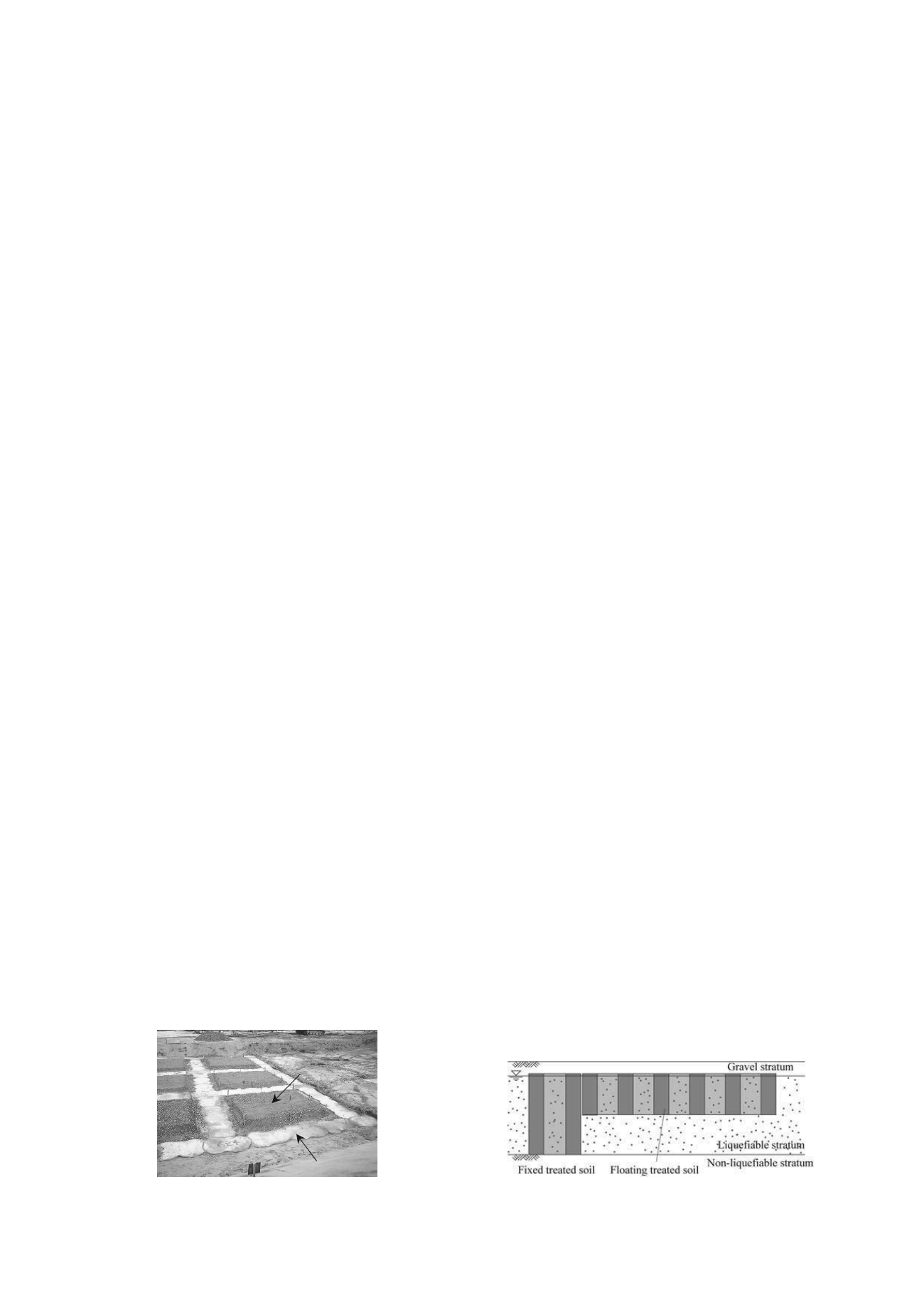
1619
Experimental study on lattice-shaped cement treatment method for liquefaction
countermeasure
Étude expérimentale d’un procédé d’anti-liquéfaction des sols au moyen d’un bâti en forme de
treillage en bét
Takahashi H., Morikawa Y.
Port and Airport Research Institute, Yokosuka, Japan
Iba H.
Toa Corporation, Yokohama, Japan
Fukada H.
Fudo Tetra Corporation, Tokyo, Japan
Maruyama K., Takehana K.
Geodesign Corporation, Tokyo, Japan
ABSTRACT: In the present study, a new method to improve sandy ground is proposed as a liquefaction countermeasure. It is the
floating-type and lattice-shaped cement treatment method, where cement treated soil is not fixed to an unliquefiable stratum.
However, a fixed-type structure such as treated soil should be formed at the side of the floating-type treated soil to reduce its lateral
displacement. In the study, one-dimensional dynamic response analyses were firstly conducted to confirm the mechanism of the new
method. Secondly, a series of centrifuge model tests were performed to demonstrate the effect in a proto-type scale’s stress condition.
The analyses and model tests confirmed the effect of liquefaction countermeasure of the new method.
RÉSUMÉ : Dans la présente étude, nous proposons une nouvelle méthode de consolidation en terrain sableux comme une mesure
pour contrer la liquéfaction du sol. C’est une méthode qui consiste à traiter le sol au moyen d’un bâti en forme de treillage en béton de
type flottant: le terrain ainsi consolidé par le béton n'est pas amarré à une strate non liquéfiable. Cependant, afin de réduire son
déplacement latéral, il faudra construire à l’endroit du sol de type flottant traité une structure de type fixe. Dans notre étude, nous
avons mené en premier lieu des analyses de la réponse dynamique à une dimension pour vérifier le fonctionnement de ce nouveau
procédé. Deuxièmement, nous avons réalisé une série de tests sur modèles centrifugés afin de montrer l’effet de la méthode mise en
œuvre lors de secousses provoquées sur des modèles réduits. Les analyses et les tests sur modèles centrifugés qui ont été menés ont
confirmé l’efficacité du nouveau procédé.
KEYWORDS: lattice shape, cement treatment, liquefaction countermeasure
1 INTRODUCTION
Liquefaction induced by earthquake generates sand boiling and
ground settlement. Other problems were also reported,
including the decrease of bearing capacity and the increase of
horizontal earthpressure against retaining walls. To prevent
those problems caused by liquefaction of ground, various
countermeasure methods have been proposed, such as the
cement deep mixing and the high-pressure jet mixing methods.
Those methods have a big advantage of being able to be applied
for ground that contains fine-grain fraction soil. Furthermore,
the controversial displacement caused by the construction can
be reduced. In Japan, a lattice-shaped cement treatment method
has been frequently used for many construction sites to prevent
liquefaction, where cement-treated piles are intersected to form
the lattice as shown in Fig. 1. The lattice-shaped walls can
reduce shear stress generated by earthquake in liquefiable sandy
ground, restricting the liquefaction there. Meanwhile, the
construction cost of the cement treatment is relatively higher
than other methods, such as the Sand Compaction Pile (SCP)
method, and expected to be cut down. Especialy, the cost of the
high-pressure jet mixing method, which can be applied for the
liquefiable ground under exsiting structures, is significantly
high. Therefore, decreasing total volume of cement treatment is
required with the aim of reducing the construction cost.
In the present paper, the new method as shown in Fig. 2 is
proposed as a liquefaction countermeasure in which the lattice-
shaped treatment soil is not fixed to an unliquefiable stratum
below a liquefiable layer, namely a floating-type improvement
method. The fixed-type structure such as cement treated soil
should be formed at the side of the floating-type treated soil to
reduce its lateral displacement. It can synchronize the lateral
motions of the floating-type treated soil and unliquefiable
stratum, and reduce shear stress of an in-between stratum,
preventing the liquefaction.
In the study, one-dimensional dynamic response analyses
were firstly conducted to verify the mechanism of the new
method. Secondly, a series of centrifuge model tests were
Figure 1. Surface of ground improved by lattice-shaped cement
treatment method
Figure 2. Schematic view of floating-type and lattice-shaped treatment
method
Untreated soil
Cement treated soil
on


